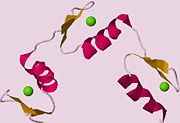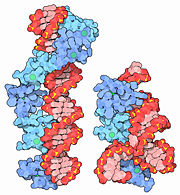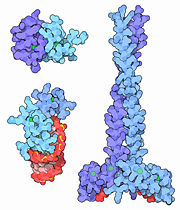Zinc Fingers
From Proteopedia
(Difference between revisions)
(→Exploring the Structure) |
|||
| Line 4: | Line 4: | ||
scene='Zinc_Fingers/Zinc_finger_initial/3' size="400" frame="true" align="right" script='Zinc_Fingers/1zaa/1' caption='Zn stabilize the structure of Zinc Finger Domain'/> | scene='Zinc_Fingers/Zinc_finger_initial/3' size="400" frame="true" align="right" script='Zinc_Fingers/1zaa/1' caption='Zn stabilize the structure of Zinc Finger Domain'/> | ||
| - | + | The textual content of this page has been removed due to copyright issues. We have some wonderful green scene links that were built, but we need to build text around them to put them into context. Please do so! | |
| - | <scene name='Zinc_Fingers/Zinc_finger_initial/6'>Zinc</scene> is an important element in | + | <scene name='Zinc_Fingers/Zinc_finger_initial/6'>Zinc</scene> is an important element in stabilizing the structure of zinc finger domain, the zinc finger domain will unfold without its zinc elements. |
| - | == Small and Mighty == | ||
| - | |||
| - | Our cells, on the other hand, often use a zinc atom to take a short cut. By arranging two cysteines and two histidines close to each other in a chain, a protein can grab a zinc ion and fold tightly around it. In these proteins, termed zinc fingers, a short chain of 20-30 amino acids is enough to create a solid, stable structure. Zinc fingers are so useful that they are found in thousands of our proteins, and are common in all plants and animals. Surprisingly, however, bacteria do not appear to take advantage of these little structures. | ||
| - | |||
| - | == Sticky Fingers == | ||
[[Image:MotM 1tf6-1un6.jpg |left |thumb | left: [[1tf6]] DNA (red) with 6 zinc fingers (blue). right:[[1un6]] and [[2hgh]] ribosomal RNA (red) with 3 zinc fingers (blue)]] | [[Image:MotM 1tf6-1un6.jpg |left |thumb | left: [[1tf6]] DNA (red) with 6 zinc fingers (blue). right:[[1un6]] and [[2hgh]] ribosomal RNA (red) with 3 zinc fingers (blue)]] | ||
| - | Many zinc fingers play essential roles in DNA recognition. Zinc fingers were originally discovered in the transcription factor TFIIIA from frog eggs, which contains nine zinc fingers in a row. The two structures shown here capture pieces of this protein performing its functions. [[1tf6]], shown on the left, includes 6 of the zinc fingers (blue) bound to a long stretch of DNA (red). With this interaction, TFIIIA helps control the transcription of the gene for a ribosomal RNA. TFIIIA also binds to the ribosomal RNA itself, [[1un6]] and [[2hgh]], on the right. These structures include 3 of the 9 zinc fingers (blue), along with a small piece of the ribosomal RNA (red). In the frog eggs, about 10 billion copies of this protein help to stabilize the many copies of RNA as the cell develops. | ||
| - | == Modular Recognition == | ||
| - | |||
| - | As you can see from these structures, the string of zinc fingers curls along the DNA or RNA strands, binding in the grooves and extending amino acids inwards to read the bases. A single zinc finger does not bind very tightly and can only recognize 2 or 3 base pairs. But when several are strung together, the group binds more tightly and can read longer DNA sequences. This modular approach is so appealing that researchers are currently trying to design artificial zinc fingers with different specificities. Then, by linking them up in the proper order, we could create a custom zinc finger protein to read any sequence that we desire. | ||
| - | |||
| - | == Jack of All Trades == | ||
[[Image:MotM Zincfingers.jpg |right |thumb |upper left [[1y0j]], lower left [[1a1t]], right [[1joc]] ]] | [[Image:MotM Zincfingers.jpg |right |thumb |upper left [[1y0j]], lower left [[1a1t]], right [[1joc]] ]] | ||
| - | Zinc fingers come in many shapes and sizes, but they all have one or more zinc atoms (shown here in green) gripped by a combination of four amino acids, either cysteine or histidine. Zinc fingers perform many different jobs, as shown in these three sample structures. The complex at upper left [[1y0j]] shows zinc fingers from two longer proteins, GATA-1 (which contains two zinc fingers) and FOG-1 (which contains 9 zinc fingers). The specific interaction between these two zinc fingers plays an essential role in the development of blood cells. The HIV-1 nucleocapsid protein shown at lower left [[1a1t]] contains two zinc fingers that grip the viral RNA during budding of the virus. The protein EEA1, shown at the right [[1joc]], contains two zinc fingers in each chain. It binds to a special lipid found in endosomes, and plays an essential role in transporting molecules to that cellular compartment. | ||
== Exploring the Structure == | == Exploring the Structure == | ||
<applet load='1znf' scene='Zinc_Fingers/Zinc_fingers/2' size='400' frame='true' align='right' /> | <applet load='1znf' scene='Zinc_Fingers/Zinc_fingers/2' size='400' frame='true' align='right' /> | ||
| - | + | <scene name='Zinc_Fingers/Zinc_fingers/1'>25 amino acids</scene> | |
| - | <scene name='Zinc_Fingers/Zinc_fingers/1'>25 amino acids</scene> | + | |
| + | <scene name='Zinc_Fingers/Zinc_fingers_cys/3'>two cysteines</scene> | ||
| + | |||
| + | <scene name='Zinc_Fingers/Zinc_fingers_his/4'>two histidines</scene> | ||
| + | |||
| + | <scene name='Zinc_Fingers/Zinc_fingers_phe/2'>a phenylalanine</scene> | ||
| + | |||
| + | <scene name='Zinc_Fingers/Zinc_fingers_leu/1'>a leucine</scene> | ||
| + | |||
| + | <scene name='Zinc_Fingers/Zinc_fingers_1zaa_dna/3'>three linked zinc fingers</scene> | ||
| + | |||
| + | <scene name='Zinc_Fingers/Zinc_fingers_1zaa_dna/4'>The amino acids shown in red read the DNA</scene> | ||
{{Clear}} | {{Clear}} | ||
| Line 37: | Line 36: | ||
# [http://en.wikipedia.org/wiki/Zinc_finger Zinc Finger in Wikipedia] | # [http://en.wikipedia.org/wiki/Zinc_finger Zinc Finger in Wikipedia] | ||
# [http://www.zincfingers.org/ Zinc Finger Consortium] | # [http://www.zincfingers.org/ Zinc Finger Consortium] | ||
| + | # [http://mgl.scripps.edu/people/goodsell/pdb/pdb87/pdb87_1.html Molecule of the Month on Zinc Fingers] by David Goodsell | ||
== Content Donators == | == Content Donators == | ||
| - | Currently ( | + | Currently (Aug 20 2008), many images on this page are the work of David S. Goodsell, who has given permission for their inclusion in [[Proteopedia]]: |
* Content adapted with permission from David S. Goodsell's [http://mgl.scripps.edu/people/goodsell/pdb/pdb87/pdb87_1.html Molecule of the Month on Zinc Fingers] | * Content adapted with permission from David S. Goodsell's [http://mgl.scripps.edu/people/goodsell/pdb/pdb87/pdb87_1.html Molecule of the Month on Zinc Fingers] | ||
Revision as of 10:29, 20 August 2008

Cartoon representation for Zinc Finger 1zaa with Zn atoms (green)
|
The textual content of this page has been removed due to copyright issues. We have some wonderful green scene links that were built, but we need to build text around them to put them into context. Please do so!
is an important element in stabilizing the structure of zinc finger domain, the zinc finger domain will unfold without its zinc elements.
Exploring the Structure
|
Additional Information
- Zinc Finger in Wikipedia
- Zinc Finger Consortium
- Molecule of the Month on Zinc Fingers by David Goodsell
Content Donators
Currently (Aug 20 2008), many images on this page are the work of David S. Goodsell, who has given permission for their inclusion in Proteopedia:
- Content adapted with permission from David S. Goodsell's Molecule of the Month on Zinc Fingers
Proteopedia Page Contributors and Editors (what is this?)
Ala Jelani, Ann Taylor, Eran Hodis, Michal Harel, Tyler Combs, Joel L. Sussman, David Canner, Eric Martz


